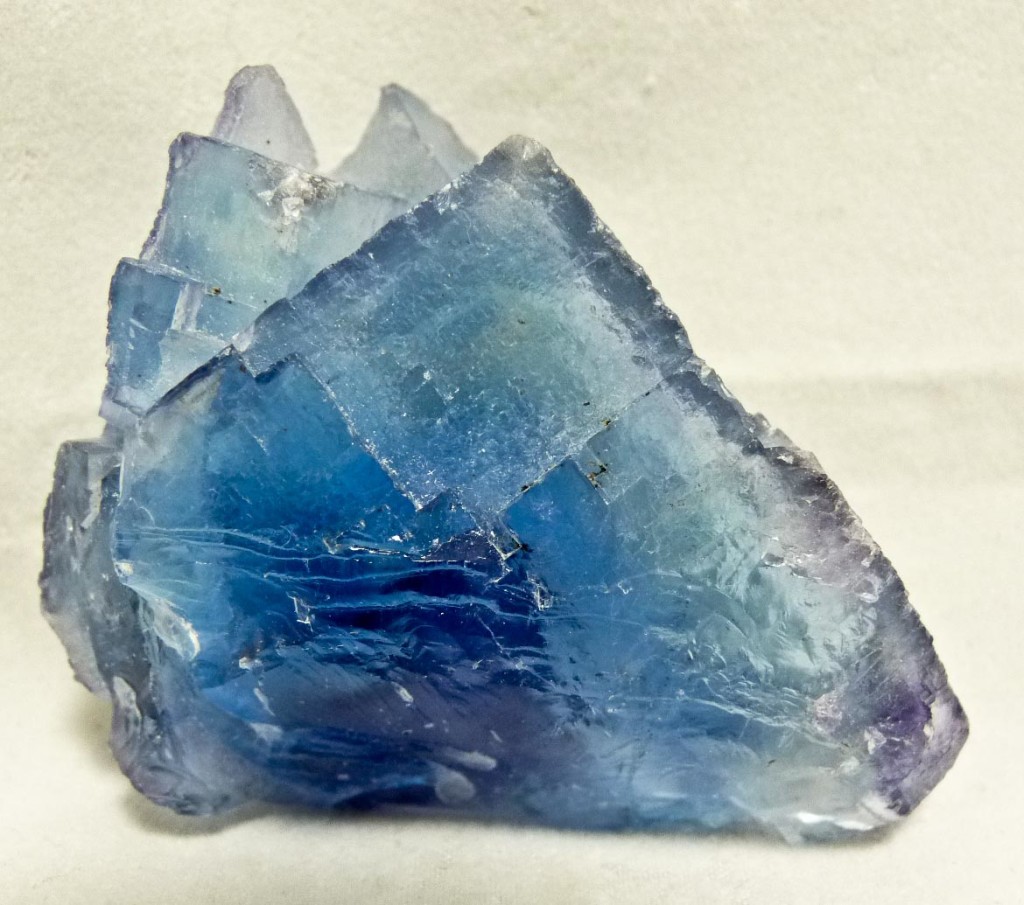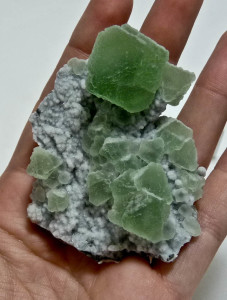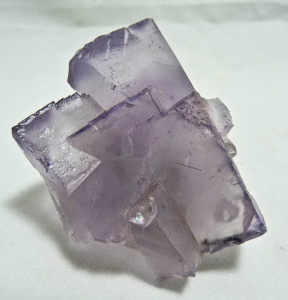Fluorite is an isomeric mineral with the formula CaF2- it is naturally occurring calcium fluoride. In the crystal structure of fluorite, each atom of calcium is surrounded by eight fluoride anions which are positioned at the corners of a cubic lattice surrounding the calcium. Fluorite has unusual cleavage for a mineral- it actually has four cleavage directions and it is for this reason that it can be easily cleaved into octahedrons. The cleavage in all four directions is perfect meaning it is very easy to cleave fluorite specimens. Fluorite is very soft with a Moh’s hardness of only 4. Therefore, fluorite specimens must be handled with care or they will be easily damaged. Due to its softness and high amount of cleavage, fluorite is only occasionally faceted and cut stones are only popular among collectors for the most part though fluorite is often used in carvings because large colorful pieces are quite abundant.
Fluorite itself is colorless though it can be found in every color and shade imaginable and can also display fluorescent, phosphorescent, and thermoluminescent properties. These properties are caused by impurities or structural defects in fluorite. These color forming impurities are of two types- they either substitute calcium or fluorine atoms in the structure or are present as microscopic inclusions that shift the color by filtering and/or scattering light. Fluorite is colored by a variety of extremely complicated mechanisms.
can also display fluorescent, phosphorescent, and thermoluminescent properties. These properties are caused by impurities or structural defects in fluorite. These color forming impurities are of two types- they either substitute calcium or fluorine atoms in the structure or are present as microscopic inclusions that shift the color by filtering and/or scattering light. Fluorite is colored by a variety of extremely complicated mechanisms.
The most common color causing substitutional impurities in fluorite are rare earth ions, particularly yttrium, neodymium, samarium, and cerium. These rare earths show high affinity towards fluorine and are very chemically similar to calcium in their chemistry. Fluorite may concentrate these impurities in high enough quantities to be profitable rare earth ores. Fluorite rich in rare earth impurities is typically formed as a hydrothermal, metamorphic, or metasomatic process. Structural vacancies- sites in the fluorite lattice that are not occupied by atoms and can be thought of as atomic scale holes in the structure. This space gets occupied by an electron which creates a color center.
Fluorite can also be colored by inclusions which scatter and/or absorb light. The most  common kind of inclusion in fluorite are microscopic beads of petroleum that scatter light. This type of inclusion is common in fluorite from sedimentary and Mississippi Valley type (MVT) occurrences such as those near Cave-In-Rock, Illinois, and Elmwood, Tennessee, and creates shades of purple, yellow, and blue. Inclusions of other minerals can also have the same type of effect. Recent research has suggested that colloids of metallic calcium may also cause coloration in fluorite.
common kind of inclusion in fluorite are microscopic beads of petroleum that scatter light. This type of inclusion is common in fluorite from sedimentary and Mississippi Valley type (MVT) occurrences such as those near Cave-In-Rock, Illinois, and Elmwood, Tennessee, and creates shades of purple, yellow, and blue. Inclusions of other minerals can also have the same type of effect. Recent research has suggested that colloids of metallic calcium may also cause coloration in fluorite.
Fluorite often has fluorescent, phosphorescent, or thermoluminescent properties caused by many of the same impurities that create colors in visible light. If you are a fan of fluorescent minerals, it is a good idea to check all of your fluorite specimens with a short wave ultraviolet light. You will llikely be surprised by your findings. Some fluorites are so fluorescent, they can be observed glowing in daylight. Green fluorite from the Rogerley Mine in Weardale, UK is especially well known for this phenomenon. Many of the green fluorites from this mine show an eerie purple glow when held in the sunlight.
 Fluorite’s high degree of crystal symmetry give it the property of balancing energies and emotions. Carrying amulets of fluorite or loose crystals helps to ground our emotions and personal energy states, allowing us to attain a zen like being and tune out the stresses of the everyday world. Fluorite is a known attractor of wealth, prosperity, and success. It can connect with Akashic records to allow in psionic communication with the past. Fluorite also channels harmonic resonances of the soul-being against possible psychic attacks by. It is a purifying, blocking, and grounding stone. Fluorite has been told about in many texts scribed by ancient alchemists.
Fluorite’s high degree of crystal symmetry give it the property of balancing energies and emotions. Carrying amulets of fluorite or loose crystals helps to ground our emotions and personal energy states, allowing us to attain a zen like being and tune out the stresses of the everyday world. Fluorite is a known attractor of wealth, prosperity, and success. It can connect with Akashic records to allow in psionic communication with the past. Fluorite also channels harmonic resonances of the soul-being against possible psychic attacks by. It is a purifying, blocking, and grounding stone. Fluorite has been told about in many texts scribed by ancient alchemists.
